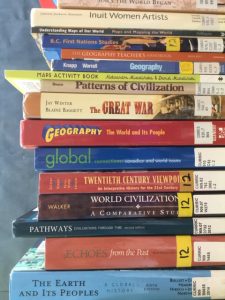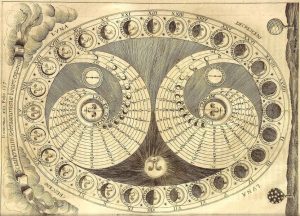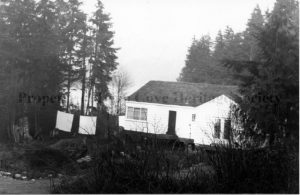
Thomas King speaks truth through code. What do I mean by that? Well, within King’s Novel, Green Grass Running Water, he utilizes a spectrum of literary and storytelling practices, which juxtapose historic injustices and truth. Despite the heavy reality these parodies unveil, King presents unsettling paradigms through humour and comparison.
One way that King weaves in his own humour and cleverness into GGRW is through the highly representational names he gives his characters. This prompts us, as the reader to question “What is in a name?” Well names are complex, and some beings, inanimate or not, may have multiple names. So what is King’s intent with his parody of names? As I try and answer my own questions I wonder how far King has interwoven internal and external narratives and themes. A specific line in the beginning of the book further prompted me to take my own ponderings outside of paper confines of the book.
On page 41, the narrator/God/Coyote is telling an origin story. This telling takes shape through a conversation between that GOD and Coyote, where despite their different story approaches, tell a tale of the beginning that brings First Woman and Ahdamn (Adam) together. The origin story is interjected with both traditional plots and characters, such as the creation of land with Grandmother Turtle, alongside the coming of the Garden. Through this rapid and conflicting hybrid story, the line that caught my mind’s eye was:
“Ahdamn is busy. He is naming everything.”
From this I wondered, is King’s naming in GGRW a response to the entitlement of naming things held by European settlers at contact? Is he intentionally prompting the reader to really consider all of his narrative choices, or are some of them as abstract as Ahdamn naming the Bear a Garage Sale? It dawned on me that maybe King is partaking in an act of decolonization, through reclaiming the power of the name.
So I found a line that would ground me in my research, but I was still unsure of the section I wanted to highlight. I re-read the ten pages after the quote as well as the ten pages before. Although the ten pages after had a copious number of recurring characters, the ten pages before offered names less common. This, I would use as a test to observe “how far” into detail, King took this naming practice.
I chose the ten pages before, which focus on a story of one of Lionel’s three mistakes. The mistake, which Lionel’s aunt Norma highly disapproves of, was him “wanting to get his tonsils removed” (page 30). As Norma considers different carpet colors, for the new carpet that will finally be received, we enter a story of Lionel’s childhood. It is through this story into the past that we learn about Lionel and the tensions around and between traditional and western medicine.
Lionel and Norma are the first two characters who commence the section I chose. Throughout, there is a consistent nagging by Norma, in regards to how Lionel has adopted western ways. What drives the conversation is the divide between values, between traditional and western medicine. Blooming from this scene, a story from Lionel’s childhood awakes.
When Lois James gets her tonsils out, Child Lionel notes the time she takes off school and the special treatment she had. So Lionel, being a smart and conniving young lad complains to his mother about his sore throat until she does something. His mother, Camelot, first takes Lionel to see Martha Old Crow, a traditional healer. To my surprise, after checking Lionel, Martha Old Crow (Martha is a biblical name) sends Lionel and his mother to see the Frog doctor, Dr. Loomis who is a white doctor from Toronto. This is where the parallels between traditional medicine and western medicine start.
Norma compares western medicine and traditional medicine as a representation of one’s values. She does this through glorifying Lionel’s sister Latisha, who chooses to see a Traditional doctor rather than a western one. Lionel counters his aunts’ proposition by emphasizing Latisha’s appreciation for George Morningstar. Morningstar, which refers to General Custer, a historic American war figure known for his duties in the American Civil war, and wars against the American Indians. King’s George Morningstar, is also a white-American, who appropriates Indigenous culture (Flick, 1999).
As we read about the polarities and places of interceptions between Indigenous and western worlds, it becomes apparent that nothing is truly homogenous. Despite one’s perception of how things “should be” such as those held by Norma, It’s clear that in reality it rarely plays out as that way. This is articulated through the scene that follows, and the one of which I started, where GOD and Coyote come together to tell a disjunctive origin story of First Woman and Ahdamn.
Works Cited
“Battle of the Little Bighorn.” History.com, A&E Television Networks, 2 Dec. 2009, www.history.com/topics/native-american-history/battle-of-the-little-bighorn.
McGonegal, Julie. “Thomas King’s Moment of Truth.” The UC Observer. 2013, www.ucobserver.org/culture/2013/09/moment_truth/.
“Native American Frog Mythology.” Native American Indian Frog Legends, Meaning and Symbolism from the Myths of Many Tribes, www.native-languages.org/legends-frog.htm.
Petkova, Veneta Georgieva. “How Thomas King Uses Coyote in His Novel Green Grass, Running Water.” Universitatis Islandiae Sigillum , May 2011, pp. 1–35.






